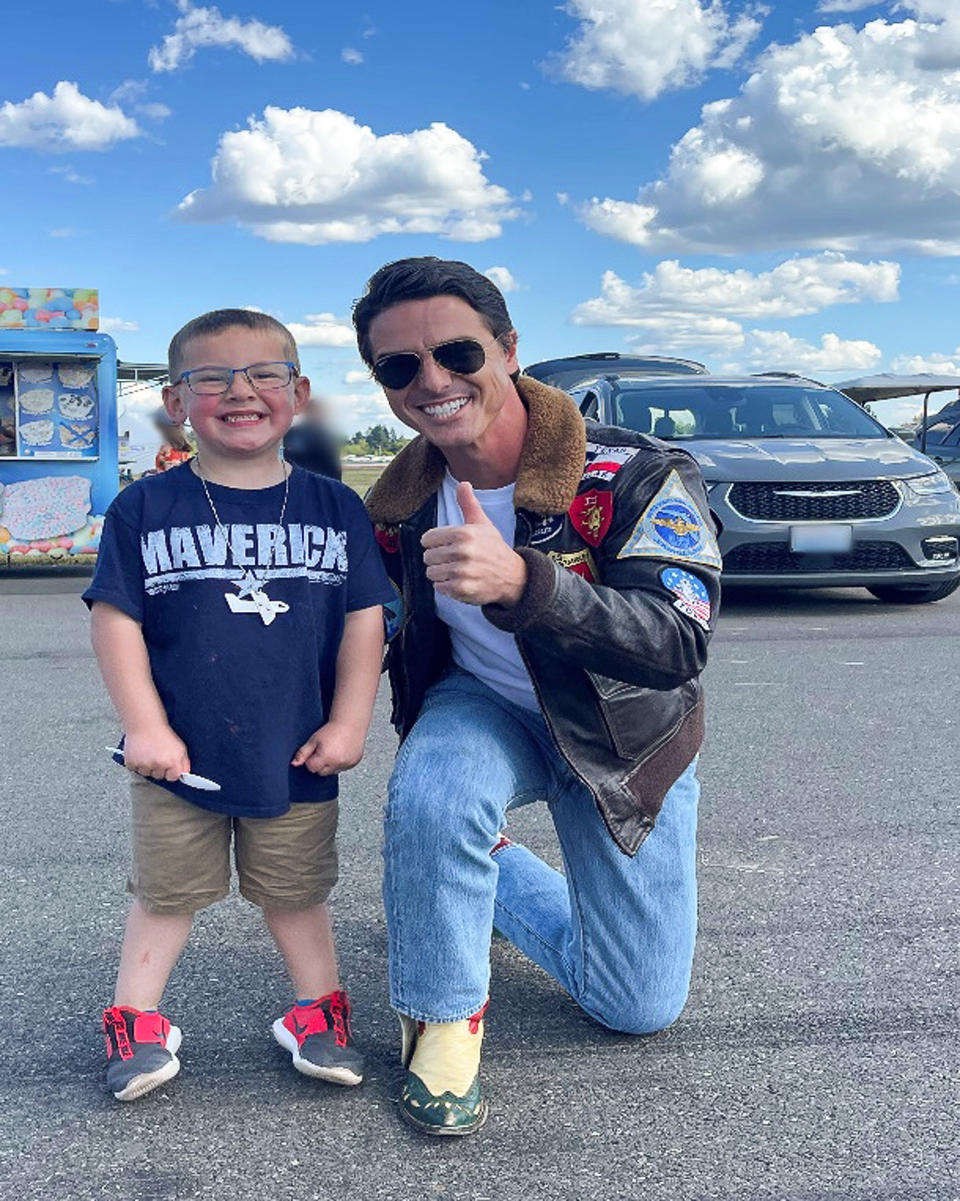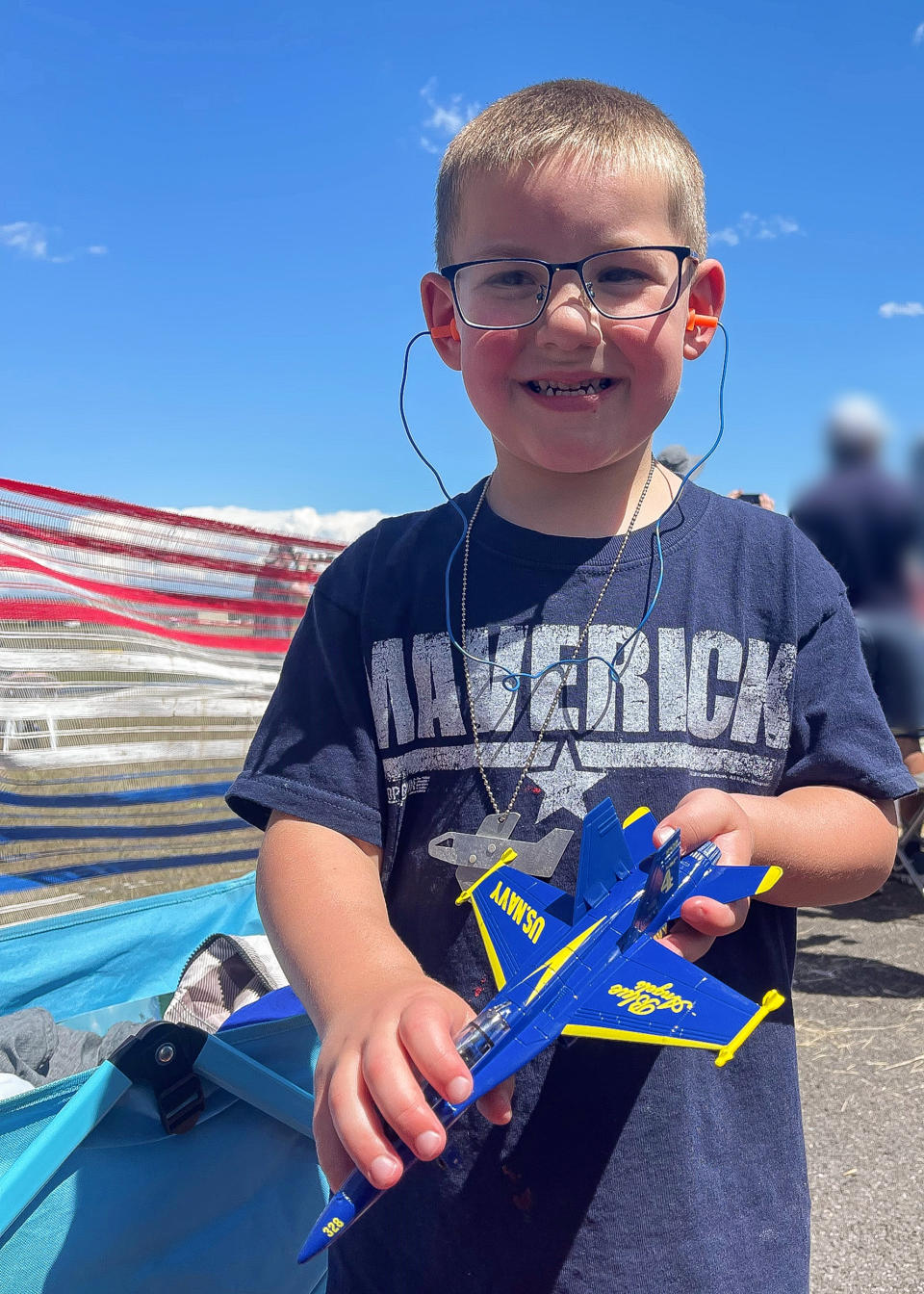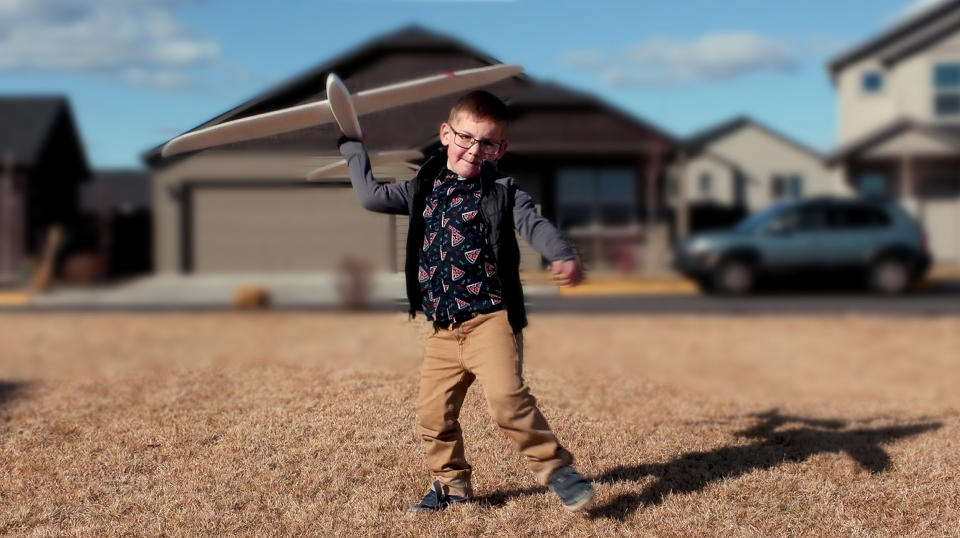Boy, 5, with 'Swiss cheese heart' now thriving after innovative surgery
At seven months pregnant in the spring of 2017, Ellyn Waler visited her doctor for an ultrasound, and the test detected an abnormality. She saw a cardiologist for a follow-up, and she and husband Brad Waler learned some devastating news: Their baby’s heart was riddled with holes.
“We were just in shock,” Ellyn Waler, 34, of Redmond, Oregon, told TODAY. “It had been a really normal pregnancy.”
The baby, Maverick, had multiple complex muscular ventricular septal defects, which are holes in the muscular wall between the right and left ventricle. Colloquially, it’s referred to as Swiss heart. Having a hole in the heart is a somewhat common cardiac defect for babies, and many surgeons understand how to repair it. But having so many holes like Maverick did meant his future was unclear.
“You have all these ideas of what pregnancy is like and what his life will be like and what the birth will be like,” Ellyn Waler said. “They were all thrown out the window at once. We were talking about ... what’s his life expectancy?”
Life with a Swiss cheese heart
Doctors sent Ellyn Waler three hours away to Portland for appointments for pediatric cardiologists and more in-depth imaging with an obstetrician. They planned to deliver Maverick by C-section at 37 weeks because it was “risky given his condition to wait too long.” After she received the epidural, Maverick’s heart rate dropped, and the doctors had to deliver him immediately.

“He really lived up to his name, and the planned C-section became an emergency,” Ellyn Waler said. “That’s how Maverick’s life started.”Maverick was born on June 14, 2017, and a nurse showed Ellyn Waler her son before he went to the neonatal intensive care. He needed undergo an MRI so they could better see his heart defects, which showed that he had holes in the upper chambers, also known as atrial septal defects, as well as in the lower chamber, ventricle septal defects. He also received oxygen as support.
“We could hold his hand, but we couldn’t pick him up. We couldn’t snuggle him,” Ellyn Waller said. “The day after he was born, he just got progressively sicker.”
Doctors knew that Maverick would need surgery soon after he was born, but he was so ill that they had to wait until he was 2 weeks old. During his open heart surgery, doctors repaired his restricted aorta, the largest artery in body, which carries blood from the heart to the rest of the circulatory system, and put in a pulmonary artery band, often used to correct congenital heart defects.
“Because of all the holes in his heart, there was a lot of blood mixing and his lungs were very very wet," Ellyn Waler recalled.
Maverick had complications after the procedure and needed to say in the hospital, taking blood thinners to prevent him from having clots. Even after he went home, he developed an infection and needed to return to the hospital for another surgery.
But after he started physical and occupational therapy, he started hitting milestones.
“Even as a baby, he was really serious and liked to sit and observe,” Ellyn Waler said. “His personality was really funny, and you could see in his eyes when the wheels started turning.”
He started thriving, and his parents felt shocked by how well the pulmonary artery band was helping him.
“We have to go to these heart procedures when they measure the pressure in his heart, and they kept telling us that things look good,” Brad Waler said. “We really were surprised that things were as good as they were.”
Maverick enjoyed daycare and playing. But then last fall, his parents noticed his oxygen saturation levels dropped.
“(His oxygen levels) would slowly start getting lower and lower as the pulmonary artery band got tighter. But they seemed to be dipping a little too low,” Ellyn Waler said. “He started to have problems with temperature differences, like in the cold, he would just start throwing up and feeling unwell. ... He start tripping and falling and having equilibrium issues.”

Doctors told the family that Maverick would need to be put on oxygen or undergo a complex surgery, a Fontan procedure, to “re-plumb” the heart and that ultimately he might need a heart transplant as an adult.
“That’s what we thought the story of his life would be until we met Dr. Bacha,” Ellyn Walen said.
Repairing a Swiss cheese heart
Atrial septal defects occur in about 2,118 babies born in the United States each year, and ventricular septal defects affect about 16,800 babies born every year, according to the U.S. Centers for Disease Control and Prevention. Some babies need surgery to fix the hole, but others close in time. What Maverick had is somewhat of an exception.
“Swiss cheese septum is different because there are multiple holes like in excess of 10 and also located … in the depths of the heart,” Dr. Emile Bacha, chief of the division of cardiac, thoracic and vascular surgery at NewYork-Presbyterian/Columbia University Irving Medical, told TODAY. “The deeper it goes, the more difficult it is to close them and close them effectively so that the patient can have a normal heart, live a normal life.”
Bacha said doctors often close septal holes in babies. But because Maverick had so many, he suspects that some surgeons worried whether the procedure would be successful.
“The problem is the surgeons that they talked to didn’t take the case because they were afraid he would die in surgery because getting to these holes and closing them would basically damage the heart in such a way that he wouldn’t have a working heart anymore,” said Bacha, also the director of congenital pediatric cardiac surgery at NewYork-Presbyterian Morgan Stanley Children’s Hospital.
Bacha learned of Maverick after the boy’s cardiologist shared his case with him and asked if Bacha thought he could help. He had experience with such complicated cases in the past.
“I knew it was going to be difficult, but I had worked on Swiss cheese septum before,” Bacha said. “I thought I could find the holes and safely close them.”
Bacha used imagery to create a 3D picture of the heart and relied on echocardiogram guidance during surgery that mapped out the anatomy of the heart to create "guideposts." While the images and maps helped, the surgery was still risky and complicated.
“There’s potential for not surviving the operation,” Bacha said.

But the surgery went well, and this procedure changed Maverick’s life.
“For all practical purposes, he’s done with any surgeries for the rest of his life,” Bacha said. “Most patients we operate on do well.”
The Walers felt stunned when he delivered this news to them.
“We thought, ‘OK, this is just the first surgery before the next step,’” Ellyn Waler explained. “When Dr. Bacha came out after surgery and talked to us, Brad said, ‘OK, so what’s the next step?' And he said that Maverick wouldn’t need anything else ever again. It was amazing, incredible news.”
Recovery
Brad Waler loves “Top Gun.” It’s the inspiration for the 5-year-old’s name. The two watch the movie together, and Maverick recently saw the new movie, his first theater experience.
“I’ve just always had a love of aviation, and that’s something that I can share with Maverick, which I think is cool,” Brad Waler said. “We went to an airshow in Portland, and we had no idea, but somebody told us there was a Tom Cruise impersonator walking around.”

Someday, Maverick hopes to meet the real Maverick. The best part about the surgery for Maverick was the plane rides from Oregon to New York City.
“He was jumping up and down on the bed, so excited,” Ellyn Waler said. “He shakes his hands together and makes a squealing sound. It’s really cute.”
Since his surgery, “every day is like Christmas.”
“When he runs, he doesn’t change colors. He doesn’t lose his breath. He can keep up with other kids. He has boundless energy,” Ellyn Waler said. “It’s the most incredible gift we get every day.”
Maverick knows he’s better, too.
“He’ll tell you, ‘I’m faster now because of my new heart,” Ellyn Waler said. “He can feel a difference.”

